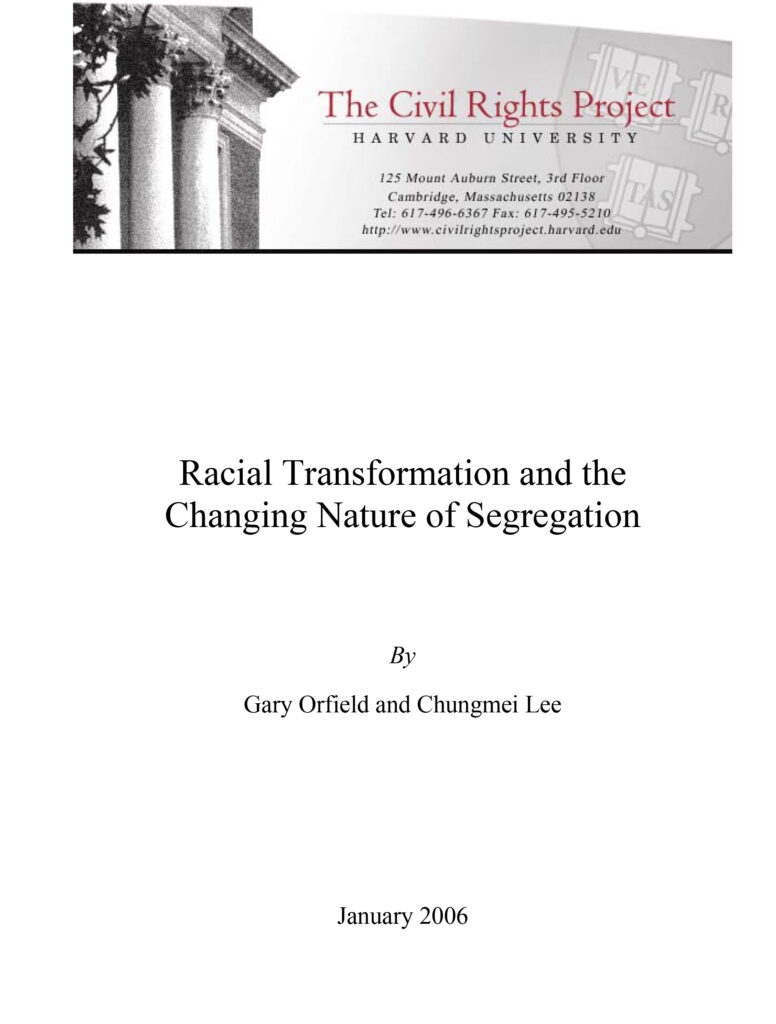Introduction
When Martin Luther King made his first speech at the Lincoln memorial in 1957 three years after the Brown decision, desegregation was about a battle to give black students access to schools previously established for whites only, mostly in the seventeen states that had practiced segregation by state law. King called for action to enforce the desegregation decision. The nation’s schools were overwhelmingly white, and when King marched against segregation eight years later in Chicago in 1965, it was still about a black-white conflict. Forty years later, however, the nation’s schools have changed almost beyond recognition; the white majority is continuously shrinking, and the segregation has taken on a multiracial character. Unfortunately, though generations of students have been born and graduated, segregation is not gone. In fact, in communities that were desegregated in the Southern and Border regions, segregation is increasing; and in regions that were never substantially desegregated, including many metropolitan areas in the Northeast, Midwest, and West, segregation is growing in degree and complexity as the nation becomes increasingly multiracial. The resegregation of blacks is greatest in the Southern and Border states and appears to be clearly related to the Supreme Court decisions in the l990s permitting return to segregated neighborhood schools. These changes, and the continuing strong relationship between segregation and many forms of educational inequality, compound the already existing disadvantage of historically excluded groups. The rapid growth of these excluded populations in conditions of intensifying segregation make urgent the development of plans and policies to transform diversity into an asset for all children and society, rather than continuing to separate children in a way that harms both those excluded from better schools and white students in those schools who are not being prepared for success in multiracial communities and workplaces of the future.
School segregation is often perceived as an old and obsolete issue. Reactions include claims that it was solved long ago, that, on the contrary, experience shows it cannot be solved, or that we have learned to make separate schools genuinely equal. None of these perceptions is true. Past research showed that, after a period of desegregation in the late 1960s, black students became increasingly resegregated in the South and Border states. Latino students, who have been excluded from serious desegregation efforts, are becoming even more segregated than black students in Southern and Western regions. Yet, despite recent trends in resegregation, the South and Border states remain among the least segregated for black students, suggesting that desegregation orders in the past have been effective, and that segregation is not an intractable issue. Further, the strong relationship between poverty, race and educational achievement and graduation rates shows that, but for a few exceptional cases under extraordinary circumstances, schools that are separate are still unquestionably unequal. Segregation is an old issue but one that is deeply rooted and difficult to resolve and extremely dangerous to ignore.
This report is about the changing patterns of segregation in American public schools through the 2003-2004 school year. We begin by examining the transformation of racial composition in the nation’s schools, the dynamic patterns of segregation and desegregation of all racial groups in regions, states, and districts by using data from 1968 until 2003-4. We examine both the changes over the last decade (1991-2003) as well as those over a much longer period (1954-2003). Data from this report are computed from the Common Core of Data of the National Center for Education Statistics of the U.S. Department of Education for the years 1988, 1991, and 2003. Where data for a given year is missing, such as the racial statistics from Georgia and Virginia for 1991, it is noted in the tables and the nearest year is substituted and noted. We then explore the relationship between racial and economic segregation, document the growing presence of multiracial schools, as well as discuss the implications of the lifting of desegregation orders on districts and the possible policy alternatives. The report ends with a brief discussion of what could be done to increase integration in schools.
In compliance with the UC Open Access Policy, this report has been made available on eScholarship:
